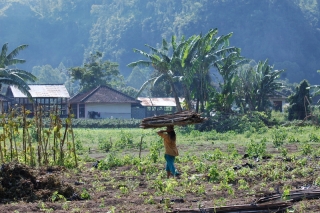We can’t write an Indonesian nutshell, but having spent four weeks in Bali and visited the north, west, east, south and central parts of the island we can probably do a pretty good nutshell here. Bali really is a holiday paradise, with accommodation and food both available for all budgets and of a good quality. But it isn’t just a ring of beaches and resorts, it’s a place packed with culture and with a beautiful rural interior waiting to be explored. If you can cope with the scary roads, grab a car and drive. For the prices below, exchange rate was 15,000 rupiah to £1 when we visited.
Accommodation
Accommodation on Bali doesn’t readily get as cheap as Thailand, but that’s because they don’t have much of a domestic market for their hotels. That said, you can stay somewhere very nice from £20 upwards. What Bali has is loads of style, everywhere we stayed was characterful and the service generally pretty wonderful. Resorts and guesthouses are often lavishly decorated, the rooms included, with tropical plants scattered wherever they will grow. If you’re at the coast, in most places you can get somewhere that is only a hop, skip and jump off the beach.
The one thing we didn’t do was stay in any of the top-notch resorts that litter the south coast and cocoon their guests in silk sheets and drinks on the beach for the duration. It’s just not our style.
Food
The most consistent food on Bali is the local food served in the simple warungs you can find everywhere. Just ask for a nasi campur, or whatever dish the warung specialises in. It will cost no more than £3 and will arrive quickly and be tasty – provided you like highly flavoured and often spicy food. It’s not the most salubrious dining, and often the choice of drinks is water, coke or iced tea. We love the warungs though. Another great warung speciality in some parts is babi guling, roast suckling pig served on rice with various other bits and pieces.
Food in tourist restaurants (if there’s a place called ‘Warung Whatever’ in a tourist area, it isn’t a warung it’s a tourist restaurant – most warungs don’t bother calling themselves such) can be much more refined and even more delicious than warung food, or it can be barely adequate but overpriced attempts at local or western dishes. When you rock up at a tourist restaurant don’t worry about “eating local”, just pick whatever on the menu you like – unlike elsewhere in Asia, they’ve been catering for tourists so long on Bali that the lasagne is likely to be as good as the nasi goreng. And it’s still a bargain compared to eating out at home; we had meals with a £4 main course that I might expect to pay £20 for in England.
Drink
In local warungs you might only get coke, water or bottled iced tea – which is good, in my opinion.
Coffee on Bali was almost invariably poor. The cheap local style is to add hot water to ground coffee in a cup, similar to Turkish or Greek but it’s a longer drink and the coffee used is rougher. Naturally there’s a lot of espresso machines around, but the results are generally adequate at best.
For alcohol you’ll either take to the cocktail habit, which is where the Balinese excel at adding alcohol to fruit, or you’ll drink beer. In most places it will be the standard golden fizzy stuff, Bintang. Some better restaurants offer a local brewery called Storm Brewing which produces a selection of much better beer, including a great pale ale. Don’t drink wine on Bali, I beg you. The selection available is generally poor and the price atrocious. My very favourite was our resort in Pemuteran where you could get a bottle of Jacob’s Creek shiraz (served chilled) for £52. Plenty of other places were almost as bad. If you want a glass of wine without paying through the nose, the locally produced Hatten wines are drinkable.
Transport
We hired a nice big and fairly new car for £12 per day, including insurance. Having done that I can’t really comment on public transport, except that it seems to be either bemos (small minibuses) or taxis. Anyway, driving is a great way to explore Bali as long as you aren’t of a nervous disposition. If any or all of the following alarm you, don’t hire a car on Bali: motorbikes driving at night with no lights, people driving down the wrong side of the road, chickens running out into the road, motorbikes overtaking you on the outside and inside at the same time, people pulling out of side roads without looking, motorbikes with ten year olds driving them, people ignoring traffic lights if it looks fairly safe, occasional potholes deep enough to swallow an elephant.
Weather
We were on Bali in the monsoon season, in February. This meant several afternoons and evenings where the heavens opened and water poured down in torrents for hours. There were other days where steady drizzle set in for the day, though my recollection is that mostly mornings were fine if cloudy. There wasn’t much sun, but more in the far east and south. And upon reflection the rain didn’t actually significantly spoil or change our plans at all, though we may have been lucky in that. I think it’s perfectly possible to enjoy Bali in monsoon season, and certainly it’s less busy. Oh, it was also always hot, so if you like swimming in the hotel pool in pouring rain then by all means do.
Scams and hassle
We didn’t see much hassle, and weren’t scammed. In obvious tourist towns like Sanur and Ubud there’d be a guy on every corner muttering “transport, you want taxi?” but that just becomes background noise. There were a few obvious touts loitering around the Gunung Batur area, and although they didn’t trouble us it’s clear that in the high season they’ll be crawling out of the woodwork.
Crime and security
We didn’t encounter any criminal behaviour on Bali, though we were careful as ever.
Hiking and wildlife watching
You don’t really come to Bali for wildlife, although there are birds aplenty in the mornings. Most of them seem to be yellow-vented bulbuls. Bali only has one really wild area, the Bali Barat National Park, and there are just a handful of animals there which aren’t easy to see. Of course once you get offshore and into the sea it’s a different story. We only went snorkelling, and loved the experience both in the east at Amed and in the west at Pemuteran (Pulau Menjangan). In both places you can go into the water straight off the beach and within literally ten yards you’re seeing coral and fishes in dazzling numbers.
There are meant to be plenty of good hikes on Bali, but we didn’t get to do any really. Part of the reason was the tropical heat and humidity; a walk longer than an hour is really unappealing when you know you’ll be pouring with sweat and the clothes sticking to your back. The weather may be more equable at other times of the year.
Regional variations

Denpasar is the main city of Bali, squatting in the south like a big ant nest with a horrible one-way system. The major tourist areas of Kuta, Legian, Sanur, Seminyak and Nusa Dua are all now simply suburbs of Denpasar; you can get from the city centre to the beach at any of them without passing a paddy field. It’s flat, hot, and has everything you could need. North of Denpasar is the artistic and craft centre of Bali, focussed on the town of Ubud. It somehow maintains an uneasy balance between cappuccinos and paddy fields. The west of the island is mostly the Bali Barat NP and some lovely mountain roads through rural landscapes. The same is true of the centre of the island, around the main volcanoes; lots of rural life and in some villages people even wave at you as though you were back in Madagascar. The north coast is flat again, but also lined with small villages and occasional wannabe resort areas like Lovina and Pemuteran; Bali of twenty years ago maybe. The east is our favourite, the Amed coast having just a handful of small resorts and lots of fishing villages. There are even less roads around here.
Conclusion
Bali was a revelation to me, having expected to find an uninteresting holiday island dedicated to gratifying sun-seekers. But by utterly ignoring the resort-strewn sands of the south we found enough culture, landscape, cuisine and nature to keep us entertained for ages without breaking even a modest budget.
We liked best:
- Relaxing in Meditasi and snorkelling off the chilled Amed coast
- Snorkelling off Pulau Menjangan, in Bali Barat national park
- Exploring the beautiful market gardens in the volcano of Gunung Batur
- Devouring delicious food in local warungs
- Enjoying the magical cultural performances in Ubud
We liked least:
- Balinese drivers, particularly moped maniacs. Totally insane, all of them
- Tummy problems in Ubud, and we never did determine the culprit
- The one-way system in Denpasar. You spin me round, round baby right round…
Related Images:
This entry was posted
on Tuesday, March 8th, 2011 at 6:39 am and is filed under Country Summary, Indonesia.
You can follow any responses to this entry through the RSS 2.0 feed.
You can leave a response, or trackback from your own site.













































